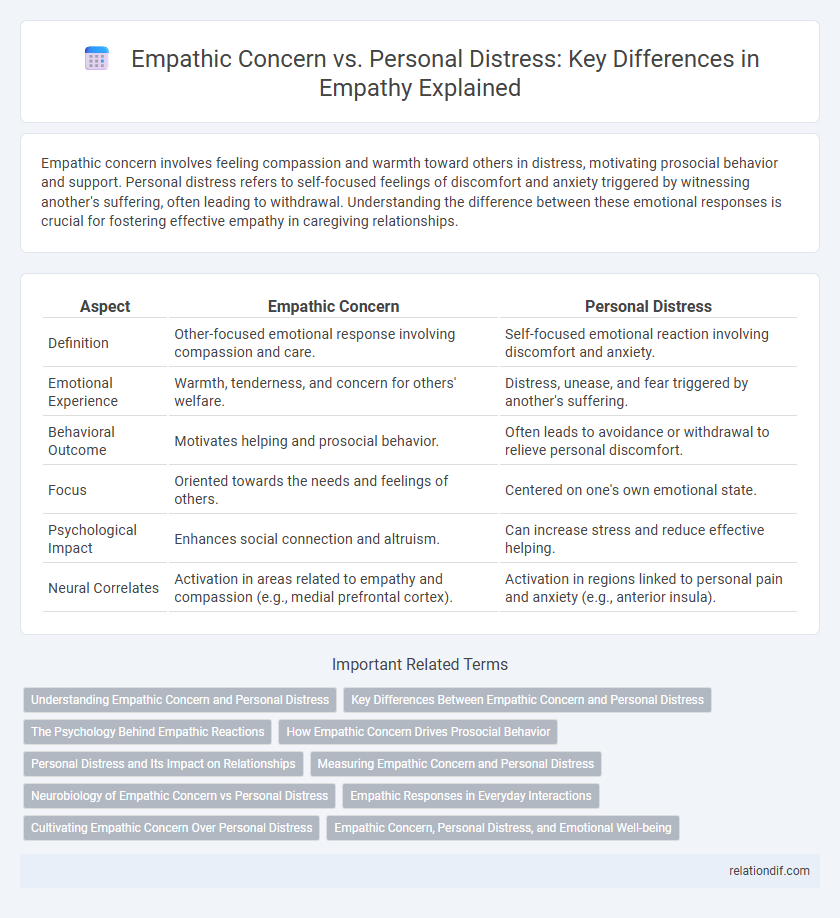Empathic concern involves feeling compassion and warmth toward others in distress, motivating prosocial behavior and support. Personal distress refers to self-focused feelings of discomfort and anxiety triggered by witnessing another's suffering, often leading to withdrawal. Understanding the difference between these emotional responses is crucial for fostering effective empathy in caregiving relationships.
Table of Comparison
| Aspect | Empathic Concern | Personal Distress |
|---|---|---|
| Definition | Other-focused emotional response involving compassion and care. | Self-focused emotional reaction involving discomfort and anxiety. |
| Emotional Experience | Warmth, tenderness, and concern for others' welfare. | Distress, unease, and fear triggered by another's suffering. |
| Behavioral Outcome | Motivates helping and prosocial behavior. | Often leads to avoidance or withdrawal to relieve personal discomfort. |
| Focus | Oriented towards the needs and feelings of others. | Centered on one's own emotional state. |
| Psychological Impact | Enhances social connection and altruism. | Can increase stress and reduce effective helping. |
| Neural Correlates | Activation in areas related to empathy and compassion (e.g., medial prefrontal cortex). | Activation in regions linked to personal pain and anxiety (e.g., anterior insula). |
Understanding Empathic Concern and Personal Distress
Empathic concern involves feelings of compassion and care directed towards others experiencing suffering, motivating prosocial behavior and support. Personal distress, by contrast, is a self-focused emotional reaction characterized by discomfort and anxiety when witnessing another's pain, which can inhibit helping behavior. Differentiating these responses is crucial for enhancing emotional regulation and effective empathy in social and clinical settings.
Key Differences Between Empathic Concern and Personal Distress
Empathic concern involves other-oriented feelings of compassion and care that motivate prosocial behavior, while personal distress is a self-focused emotional response characterized by discomfort and anxiety. Empathic concern promotes altruistic actions aiming to reduce another's suffering, whereas personal distress often leads to avoidance to alleviate one's own emotional discomfort. Neuroimaging studies show distinct brain activations for empathy-related regions during empathic concern compared to heightened self-regulatory areas during personal distress.
The Psychology Behind Empathic Reactions
Empathic concern involves an other-focused emotional response characterized by feelings of compassion and a genuine desire to help, driven by cognitive processes of perspective-taking and emotional resonance. Personal distress, on the other hand, is a self-focused, aversive reaction involving discomfort and anxiety in response to another's suffering, often leading to withdrawal behaviors to reduce one's own distress. Neuroscientific studies reveal distinct brain activations in regions such as the anterior insula and anterior cingulate cortex, highlighting the psychological mechanisms underlying empathic concern versus personal distress.
How Empathic Concern Drives Prosocial Behavior
Empathic concern, characterized by feelings of compassion and warmth toward others' suffering, strongly motivates prosocial behavior by fostering an altruistic desire to help. Unlike personal distress, which involves self-focused discomfort and can lead to avoidance, empathic concern directs attention outward, encouraging supportive actions that benefit both individuals and communities. Research in social psychology consistently shows that higher empathic concern correlates with increased volunteering, charitable giving, and cooperative behavior.
Personal Distress and Its Impact on Relationships
Personal distress is a self-focused emotional reaction characterized by feelings of anxiety and discomfort when witnessing others' suffering, often leading to withdrawal rather than supportive behavior. This intense personal discomfort can strain relationships by reducing the individual's capacity for empathy and effective communication. Chronic personal distress may hinder conflict resolution and diminish emotional connection, ultimately impacting relationship satisfaction and stability.
Measuring Empathic Concern and Personal Distress
Measuring empathic concern and personal distress typically involves self-report questionnaires such as the Interpersonal Reactivity Index (IRI), which assesses empathic concern through items related to feelings of compassion and warmth toward others. Personal distress is evaluated by items that capture discomfort and anxiety in response to others' suffering, distinguishing it from empathic concern's outward focus on others' well-being. These measures provide critical insights into emotional responses, enabling researchers to separate self-centered distress from other-oriented empathy in social and psychological studies.
Neurobiology of Empathic Concern vs Personal Distress
Empathic concern activates brain regions such as the anterior insula and anterior cingulate cortex, facilitating prosocial behavior and emotional regulation. Personal distress primarily engages the amygdala and periaqueductal gray, triggering self-focused emotional responses and avoidance tendencies. Neuroimaging studies reveal distinct neural pathways underlying these experiences, highlighting the role of prefrontal cortex in moderating empathic concern versus personal distress.
Empathic Responses in Everyday Interactions
Empathic concern involves feelings of compassion and care for others' well-being, motivating prosocial behavior during everyday interactions. Personal distress, by contrast, triggers self-focused discomfort that may hinder effective support in social contexts. Understanding these distinct empathic responses enhances emotional intelligence and improves interpersonal relationships through appropriate emotional regulation.
Cultivating Empathic Concern Over Personal Distress
Cultivating empathic concern over personal distress involves prioritizing other-focused emotions that promote prosocial behavior and compassion rather than self-focused discomfort. Techniques such as mindfulness training and perspective-taking exercises enhance emotional regulation and decrease self-oriented distress, enabling more effective and sustained helping behaviors. Research shows that individuals with higher empathic concern experience stronger social bonds and improved mental well-being compared to those dominated by personal distress responses.
Empathic Concern, Personal Distress, and Emotional Well-being
Empathic concern involves feeling compassion and care for others' suffering, promoting prosocial behaviors and enhancing emotional well-being through constructive emotional engagement. Personal distress, in contrast, reflects self-focused anxiety and discomfort when witnessing others' pain, often leading to avoidance and decreased emotional resilience. High levels of empathic concern are associated with greater psychological well-being, whereas excessive personal distress can undermine emotional health and social functioning.
Empathic concern vs personal distress Infographic

 relationdif.com
relationdif.com